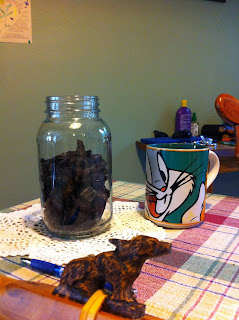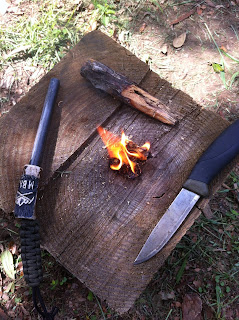We
are, Shirli and I, about to begin penning the next chapter of our
lives.
To
say that we are excited about the blank pages awaiting ahead of us is
a bit of an understatement.
Our
new digs up in the woods has been a long time in the making. The
woods environment at the cabin affords us the peaceful natural
serenity that we both personally need in our daily lives. It also
provides us with an atmosphere, away from the hustle and bustle of
mainstream society, where we can more fully practice and appreciate
our lifestyle of self-reliant
living.
What
I want to do in this blog article is to address a few questions
regarding Woodsmoke Woodcraft School. The question and answer format
will, hopefully, be clarifying and explanatory for those reading it.
What
prompted me to start WWS?
I
had been thinking about doing something like this for quite some
time.
A
few years ago, a good friend asked me if I would help with a project
that he was working on with his College and Career age Sunday School
Class. They were planning a weekend survival exercise before these
young people graduated and went off on their own into the world. My
part in the deal was to set up and give these youth a block of
instruction … basically a crash course … that focused on the Four
Essentials for Survival … Shelter, Hydration, Fire, and Food.
That
was the humble beginning of something that I've always spoken of as
of all the good and meaningful things I've done … this is the
most personally rewarding.
Where
did I learn these skills?
This
has been an ongoing course of learning for me that began early on in
life as a poor farm boy growing up.
When
most other boys were playing extracurricular sports, going to Scout
meetings, or hanging out in the town park, I was exploring and
hanging out in the woods and along the creeks. I've been in, close
to, or longing to be in the woods all these years. There have been
seasons here and there that kept me out of the woods. Those were
miserable seasons. Maybe necessary at the time but, nonetheless,
miserable. I took up golf ... imagine that ... during one of those
seasons and got fairly good at it. But it was no viable substitute
for hunting, fishing, camping, trapping, and generally
wandering the woods.
 I'm
still learning. As Horace Kephart said, “In the school of the
woods, there is no graduation day.” Why? Because there is
always more to learn. Especially where identifying and
utilizing natural resources are concerned. Nature is a
classroom with an extremely vast curriculum.
I'm
still learning. As Horace Kephart said, “In the school of the
woods, there is no graduation day.” Why? Because there is
always more to learn. Especially where identifying and
utilizing natural resources are concerned. Nature is a
classroom with an extremely vast curriculum.
Am
I self-taught?
I
have difficulty accepting self-taught as a valid concept.
Most
of what we learn is taught to us by someone in one way or another.
Even when we figure something out … supposedly on our own ...
it is because someone taught us the skills necessary to work through
a problem or challenge, see a solution, and manipulate a positive
result.
 I
have had an innumerable number of teachers along the way. And will,
as long as I breathe and have mental capacity, have more teachers.
I
have had an innumerable number of teachers along the way. And will,
as long as I breathe and have mental capacity, have more teachers.
I
read. I study. I observe. I practice until I am proficient.
This
thing … call it woodcraft or bushcraft or survivalcraft or
whatevercraft … isn't neurosurgery. Learning how to survive
in a wilderness setting doesn't take a PhD from XYZ University
either.
What
these do require is an investment of time and a commitment
to learn. It involves assembling a specific tool kit to successfully
accomplish the mission.
 One
does not necessarily have to enroll in a course at a bushcraft or
wilderness survival school to learn these skills. People can, and do,
learn a lot on their own when they apply themselves. Immersion
type courses with an instructor do, however, make it a lot easier to
get started. Especially for people unfamiliar with woods life and the
natural laws that prevail in the woods.
One
does not necessarily have to enroll in a course at a bushcraft or
wilderness survival school to learn these skills. People can, and do,
learn a lot on their own when they apply themselves. Immersion
type courses with an instructor do, however, make it a lot easier to
get started. Especially for people unfamiliar with woods life and the
natural laws that prevail in the woods.
What
is a WWS Immersion Course?
An
Immersion Course is a weekend basic wilderness skills training
course.
Participants
arrive on Friday at a designated drive-in location with their
prescribed gear (KIT). Orientation, gear review, and set-up
begins at 1:00 with instruction on course specific content during the
afternoon. More course content is covered Saturday morning. We pack
up Saturday afternoon and hike in for an overnight at a wilderness
location that removes participants from familiar amenities and
requires them to utilize their kit out there in a Lower
Alabama woodland environment. We hike out Sunday morning, summarize,
evaluate, and wrap it up at 1:00.
 Although
numerous related subjects naturally arise during the course,
the Immersion Course focuses primarily on the four essentials for
survival ... Hydration, Shelter, Fire-Making, and Food …
and how to safely satisfy these basic human needs with the
items in our kit and the resources that surround us.
Although
numerous related subjects naturally arise during the course,
the Immersion Course focuses primarily on the four essentials for
survival ... Hydration, Shelter, Fire-Making, and Food …
and how to safely satisfy these basic human needs with the
items in our kit and the resources that surround us.
How
rigorous is a WWS Immersion Course?
That
really depends upon the physical condition and health
of participants.
What
we do during a Basic Skills Immersion Course is done outdoors in
the elements that are natural aspects of the outdoors.
What we do is done with prescribed minimal gear. Simply being
outdoors, for some, may seem rigorous. A weekend
without the conveniences and entertainments of modern amenities, for
some, may seem rigorous. A weekend without the pseudo-security
of having insulated walls and locked doors, for some, may seem
rigorous.
 Participants
should, ideally, be in good enough physical shape to hike a couple of
miles with 30-35 pounds on their backs. We do not do the miles in a
fashion that resembles a forced march. We set a casual pace
and take breaks along the way. Rushing through wilderness settings
is a good way to miss out on opportunities afforded in natural
settings. Rushing is also a good way to set yourself up for some
sort of mishap.
Participants
should, ideally, be in good enough physical shape to hike a couple of
miles with 30-35 pounds on their backs. We do not do the miles in a
fashion that resembles a forced march. We set a casual pace
and take breaks along the way. Rushing through wilderness settings
is a good way to miss out on opportunities afforded in natural
settings. Rushing is also a good way to set yourself up for some
sort of mishap.
What
are my goals for WWS at this point?
There
are two goals and they are the same now as they were from the very
beginning.
 The
first is to offer course opportunities for people to learn important
foundational skills that assist them in preparing for unforeseen
circumstances. This is the taught part. I teach people skills
that can keep them alive. People learn. There's a lot of personal
reward in seeing people learn.
The
first is to offer course opportunities for people to learn important
foundational skills that assist them in preparing for unforeseen
circumstances. This is the taught part. I teach people skills
that can keep them alive. People learn. There's a lot of personal
reward in seeing people learn.
The
second is different from the first in that it is not something that
can be taught. It's something residential in the caught
department. It's that thing where people begin to see the surrounding
natural environment as a benevolent friend to be embraced rather than
as a foe to be feared.
Some
fall in love with the woods in their first encounter. Some develop a
love affair with the woods over time. Some never get it.













































